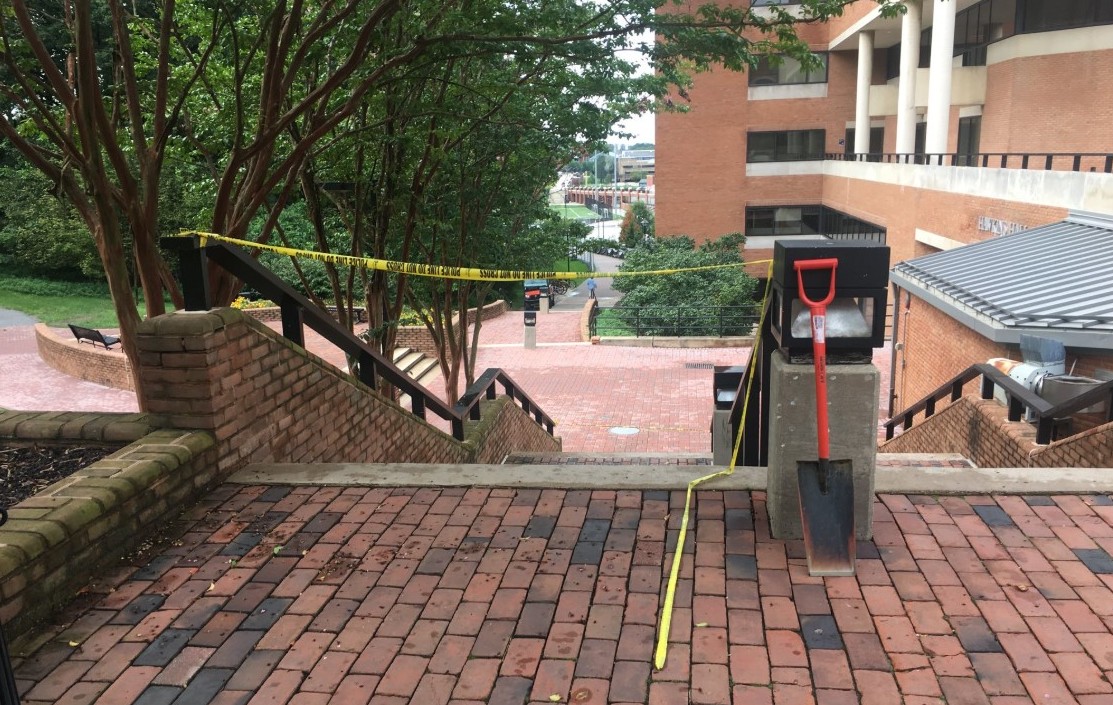
Wasps swarm students; Yellow jacket nest found near Hawkins Hall
By Mary-Ellen Davis, News Editor
Photo by Bailey Hendricks/ The Towerlight
Maria Puglese, a freshman, was walking up the stairs next to AU Bon Pain on her way to her 9:30 a.m. class when she found herself surrounded by a cloud of bees.
Puglese ran up the stairs, trying to swat the bees off, but they had followed her. She was stung 10 times.
“I didn’t do anything to provoke them,” Puglese said. “I was just walking up the stairs and the entire nest happened to be in a pipe that was embedded in the stairs.”
Puglese was not the only student attacked by the bees. According to Health Center Director Matthias Goldstein, 14 students in total were seen for stings at the Health Center with some sustaining up to 16 bee stings.
As a result of the number of students affected, Towson University sent out a campus safety alert to inform students of the danger. Sent out at 1:46 p.m. on Sept. 18, the alert warned students of swarms reported near Au Bon Pain and Hawkins Hall area, as well as the Glen ropes course.
The area was then marked by Towson Police with caution tape with the goal of keeping students away and preventing further attacks.
Senior Lee Goodrich was also stung several times by the bees as she walked down the steps by Hawkins Hall. Goodrich said she was minding her own business when the bees started to attack her, leaving “monstrous welts all over my legs.”
“I ran as fast as I could, hitting my legs trying to get the bees off,” said Goodrich.
The bees, which were later identified as yellow jackets, are naturally more aggressive during the late summer and early fall than any other time of the year according to Landscape Services Manager Donna Anderson.
According bigbluebug.com, the aggressiveness is caused by the fact that yellow jackets are territorial, and become agitated when it starts to cool down and they try to find food and shelter for the pending weather.
Facilities management took care of the nests as quickly as possible, spraying the nests with bee spray, Anderson said.
“Because the nest is in the ground and you can’t really get to it we just have to use bee spray like a homeowner would use,” said Anderson.
Anderson expects that the bee spray will be enough to take care of the located hives, but warned that they may still come up, as nests could be found anywhere. Students should also watch for hornets nests.
“We do occasionally find hornets nests and we take care of those as well,” Anderson said. “But this is the first time we’ve had a yellow jacket attack since I’ve been here.”
Community members, if stung, are encouraged by the university to go to the Health Center for treatment, which varies depending on the reaction of the individual stung.
“I went directly to the Health Center because I’ve never been stung before,” Puglese said. “When I got there, we found out I was stung eight times, but when I got back to my dorm and recounted I realized I was stung 10 times.”
Some treatments include an ice pack and hydrocortisone cream for cases of localized swelling, or oral steroids and antihistamines for more moderate reactions.
“We are fortunate that we did not have any severe reactions,” Goldstein said. “We were sort of saved by the rain. During these bee attacks it began to pour and I guess bees go home when it pours.”

